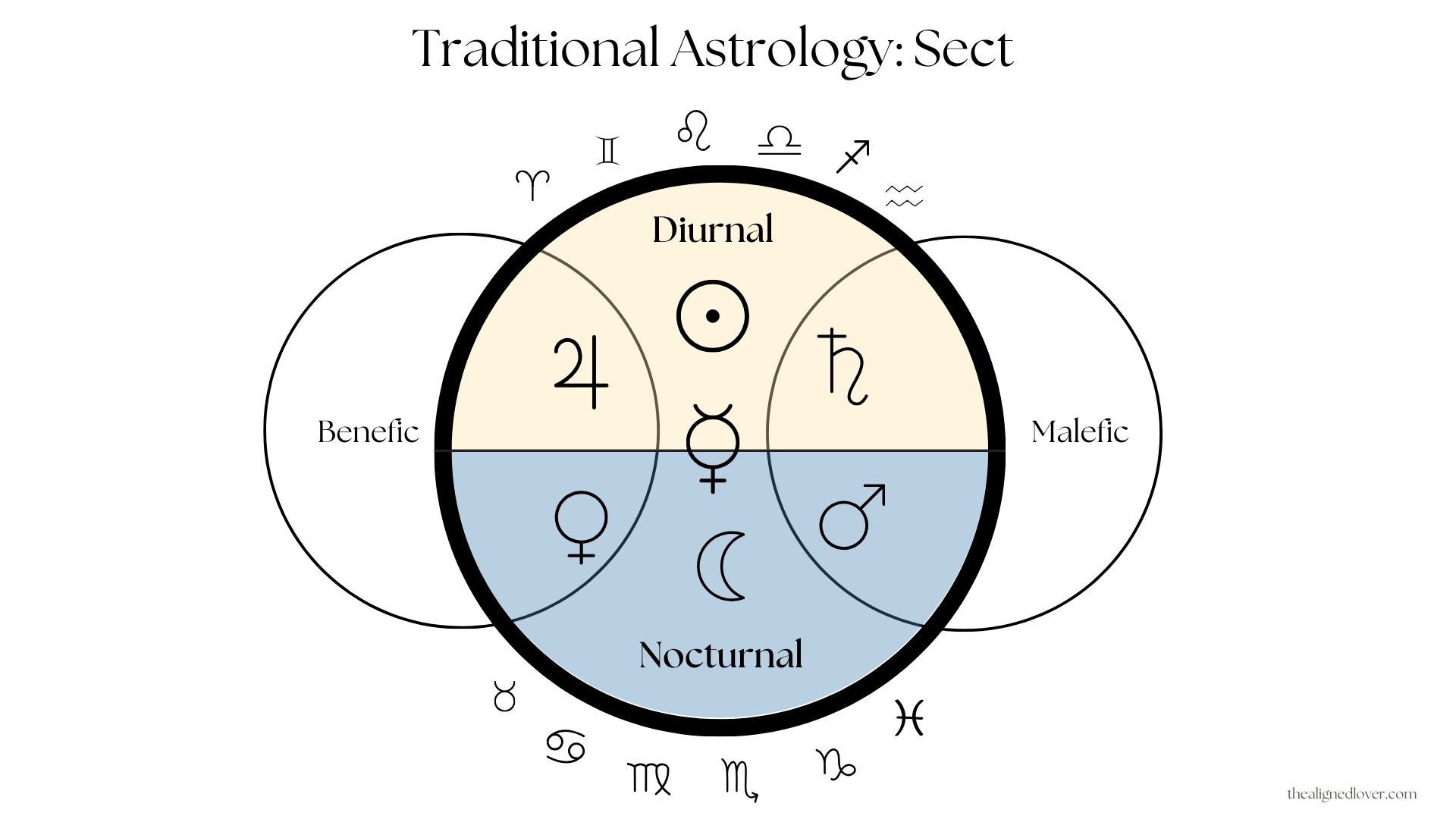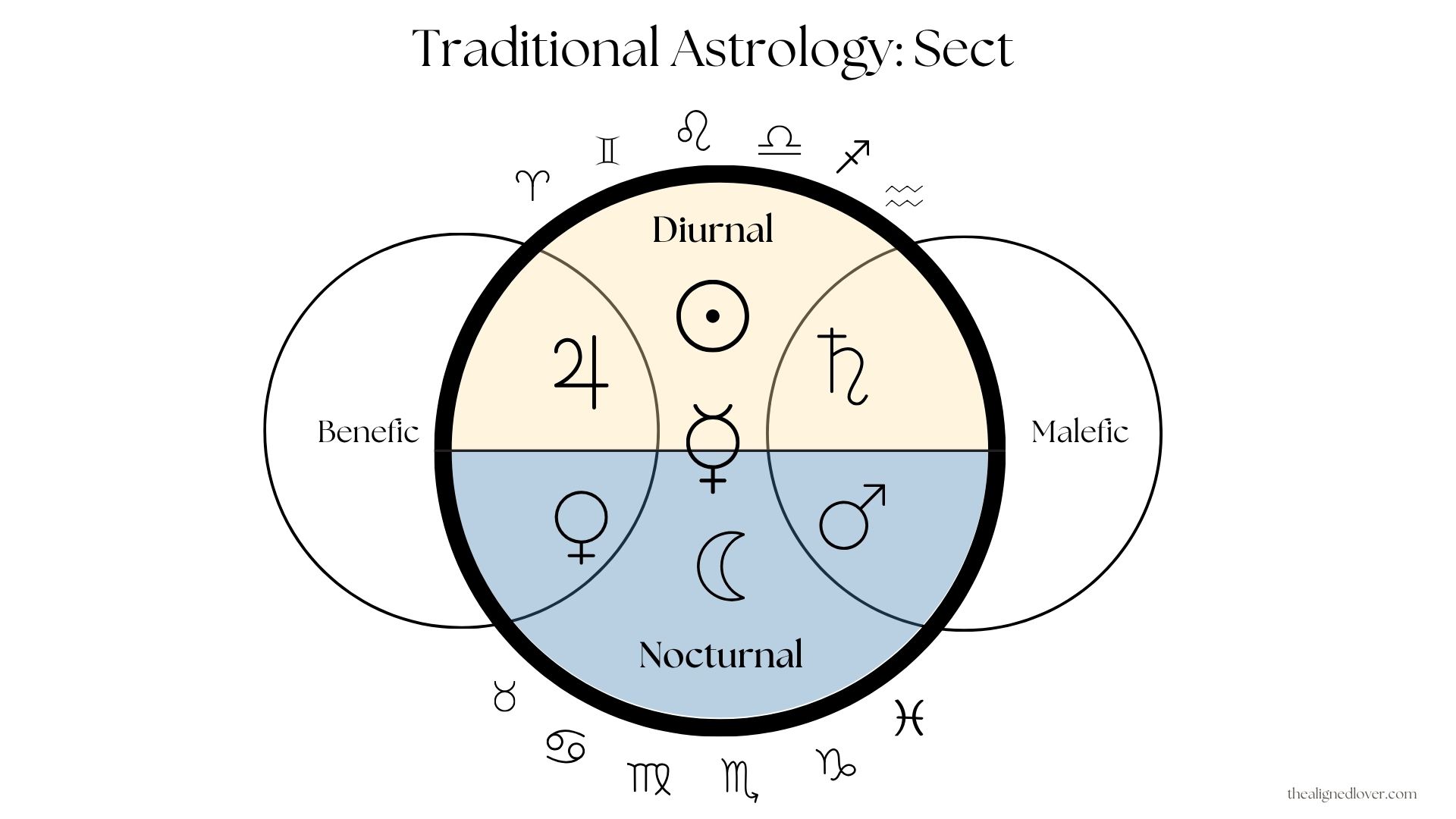One of the most crucial factors in traditional astrology is the use of sect, which seems to be completely absent in modern astrology. The use of sect divides the planets into either a diurnal or nocturnal team. This divide extends to the zodiac signs and the individual natal chart wherein the Sun’s position relative to the horizon dictates its sect.
Sect is derived from αἱρέω, which means to seize. In this context, either the Sun or Moon and their corresponding planets seize power according to the time of day.
The Diurnal Sect
The diurnal sect consists of the Sun (the sect light or luminary), Jupiter, and Saturn. The diurnal sect is masculine in polarity as it is a time of increased heat and clarity, which can be attributed to the Sun’s activity. Jupiter is diurnal as its expansive and extroverted qualities are better suited for daytime. According to Ptolemy, Saturn, a cold planet which is malefic, is considered to be less destructive when delegated to the diurnal sect. In other words, Saturn’s cold, obstructive energy is moderated and warmed by the illumination of daytime. A later astrologer, Porphyry, argues that the diurnal sect consists of the slowest moving planets who are rarely obscured by the Sun (they fall under the Sun’s beams less often).
The Nocturnal Sect
The nocturnal sect consists of the Moon (the sect light or luminary), Venus, and Mars. The nocturnal sect is feminine in polarity as it is a time of increased coolness and moistness. The Moon and Venus are both moist planets with receptive natures. According to Ptolemy, Mars, a hot planet which is malefic, is considered to be less destructive when delegated to the nocturnal sect. Mar’s impulsive, inflammatory energy is moderated and calmed by the coolness of nighttime. Porphyry asserts that the nocturnal planets are often under the beams or obscured by the Sun due to their faster motion. Being obscured by the Sun renders them impotent, and thus, these planets belong to the night sect.
Mercury: No Sect
Mercury inherently belongs to neither sect and exhibits behavior according to its position relative to the Sun. Mercury is “diurnal when it is a morning star and nocturnal as an evening star.” In other words, when Mercury rises before the Sun or is visible before daylight appears, then Mercury behaves as a diurnal planet. This will occur when Mercury is of a sign that is easier than the Sun (for example, Mercury in Gemini with the Sun in Cancer). Oppositely, when Mercury rises after the Sun or is only visible after daylight appears, then Mercury behaves as a nocturnal planet. This occurs when Mercury is in a sign that is later than the Sun (for example, Mercury in Gemini with the Sun in Taurus).

The Signs and Sect
As the diurnal sect is masculine, all of the masculine zodiac signs belong to it. The diurnal signs include Aries, Gemini, Leo, Libra, Sagittarius, and Aquarius.
As the nocturnal sect is feminine, all of the feminine zodiac signs belong to it. The nocturnal signs include Taurus, Cancer, Virgo, Scorpio, Capricorn, and Pisces.
The Sect of a Natal Chart: Day Chart vs Night Chart
Finally, the sect of a natal chart can be assessed by the position of the Sun relative to the horizon. The horizon runs from the Ascendant through the Descendant (1st to 7th House).
If the Sun is above the horizon, that means the Sun was visible during the time of birth. This begets a day chart. Oppositely, if the Sun is below the horizon, then the Sun was not visible during birth and this begets a night chart.
Within a day chart, the diurnal planets can express their strength more fully. Within a night chart, the nocturnal planets can more fully express their strength. Planets of the chart’s sect are considered to be “in sect.”
Oppositely, planets that do not belong to the chart’s sect are considered to be “out of sect.”
Rejoicing Conditions
The planets’ position relative to the horizon also influences the expression of their sect. The diurnal planets (Sun, Jupiter, Saturn) prefer to be above the horizon and the nocturnal planets (Moon, Venus, Mars) prefer to be below the horizon in a day chart. Oppositely, in a night chart, the diurnal planets prefer to be below the horizon and the diurnal planets prefer to be above the horizon.
Sect is a foundational concept in traditional astrology, anchoring the chart in the universal cycle of day and night, light and dark, visible and hidden. It frames planetary behavior not just in terms of what a planet signifies, but when and how it expresses itself most naturally. Diurnal planets gain strength through light and clarity, while nocturnal planets thrive in coolness, shadow, and moisture. By considering whether planets are in sect, out of sect, or strengthened through sect in location, we get a much more accurate sense of a planet’s temperament and effectiveness in the natal chart.
To leave sect out is to read a chart with one eye closed.
